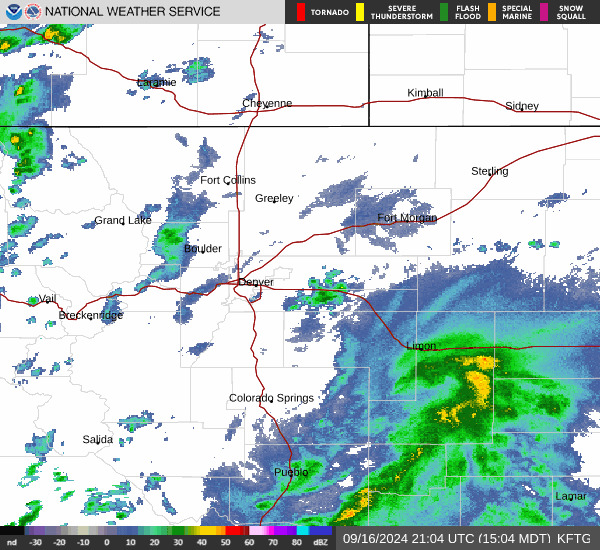A flash flood warning was issued by the National Weather Service in Denver at 1:40 p.m. on Aug. 27. This warning applies to Larimer County and includes the Alexander Mountain Fire burn scar.
The NWS warns: "This is a life threatening situation. Heavy rainfall will cause extensive and severe flash flooding of creeks, streams, and Ditches in the Alexander Mountain Burn Scar. Severe debris flows can also be anticipated across roads. Roads and driveways may be washed away in places. If you encounter flood waters, climb To safety. Move to higher ground now. Act quickly to protect your life."
See weather radar for Northern Colorado

What are NWS meteorologists saying?
At 1:40 p.m., the NWS issued a statement:
"The National Weather Service in Denver has issued a Flash Flood Warning for: The Alexander Mountain burn scar in, Southeastern Larimer County in north central Colorado, Until 4:45 p.m. MDT. At 1:40 p.m. MDT, Doppler radar indicated thunderstorms producing heavy rain over the Alexander Mountain Burn Scar. Up to 0.5 inches of rain have fallen. Additional rainfall amounts up to 0.5 inches are possible in the warned area. Flash flooding is ongoing or expected to begin shortly. Excessive rainfall over the warning area will cause debris flows near steep terrain. The debris flow can consist of rock, mud, vegetation and other loose materials.
HAZARD: Life threatening flash flooding. Thunderstorms producing flash flooding in and around the Alexander Mountain Burn Scar.
SOURCE: Radar indicated.
IMPACT: Life threatening flash flooding of areas in and around the Alexander Mountain Burn Scar. Some locations that will experience flash flooding include: Cedar Cove."
What is a flash flood?
A flash flood is a flood caused by heavy or excessive rainfall in a short period of time, generally less than 6 hours, according to the NWS. Flash floods are usually characterized by raging torrents after heavy rains. A flash flood can be sudden and violent and take just minutes to develop. It is possible to experience a flash flood in areas not immediately receiving rain.
What's the difference between a flash flood watch and a flash flood warning?
A flash flood warning is issued when a flood is imminent or occurring, the NWS says. If you are in a flood prone area, you should move immediately to high ground.The NWS issues a flash flood watch when flash flooding is possible.
What to do during a flood warning
If advised to evacuate, do so immediately.
Use a battery-operated radio or television to get the latest emergency information.
Do not walk through floodwater. Just six inches of floodwater can sweep you off your feet if it is moving swiftly.
Turn around, don't drown; do not drive into a flooded street. Cars can be swept away by two feet of moving water or there may be unseen damage to the road. If you come to a flooded area turn around and go another way. Most flood-related deaths are caused by people driving through water.
Watch out for fire hazards.
Move to higher ground.
Stay alert, turn weather notifications on.
Do not allow children to play in flowing water. Waters can hide rocks, trees and debris.
Reporters Jana Hayes and Victoria Reyna-Rodriguez contributed to this article.
This weather report was generated automatically using information from the National Weather Service and a story written and reviewed by an editor.
See the latest weather alerts and forecasts here
This article originally appeared on Fort Collins Coloradoan: Flash flood warning issued for Alexander Mountain Fire burn scar








Comments